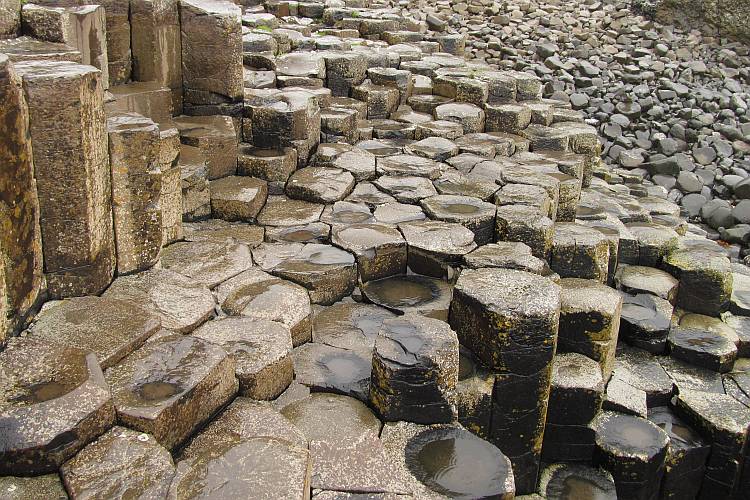Giant’s Causeway is the most popular geological tourist attraction in the island of Ireland and it was one of the places I definitely wanted to see. I have to say that it really is worth it.
Columnar basalt in itself is not an uncommon phenomenon but here it is especially well exposed and there is actually much more geologically interesting stuff to see than just the small cape named the Giant’s Causeway.
The weather was just awful — it was cold, windy, and rained all the time. I guess it was bad even according to Irish standards because there were surprisingly small number of visitors which was good.
Reddish layer of laterite (Port na Spaniagh laterite) underlying the Causeway basalts. Laterite is weathered basalt. In this case it indicates that there is a time gap between the formations of basalt layers.
Closeup of laterite. Laterite is red because of oxidized iron. Iron is plentiful in mafic rocks like basalt.
Spheroidally weathered basalt.
This seastack is known as Camel’s back. I guess it is a Bactrian camel — it has two humps. Geologically it is a dike cutting through the basalts underlying the Causeway.
There is even littlebit of sand. Giant’s Causeway is a small cape in the background.
It seems to consist mollusk shells and basalt fragments.
The columns are the real Giant’s Causeway, but the boulders resting on top of them probably represent the upper curvi-columnar (known also as entablature) part of the Causeway basalt formation.
A boulder of curvi- or pseudo-columnar basalt. It is not as regularly jointed as the main sequence because of faster cooling. This part of the sequence was closer to the surface.

Giant’s Causeway. It really is amazing even if you are prepared to see something like this.
The basalt forming the Giants’s Causeway was originally a lava lake filling a topographical depression.
Columns are the result of contraction — solid rock is denser and takes less space than liquid lava.
Lava layer loses heat through their bottom and top surfaces where the shinkage joints start to develop.
The columns have a variable number (3-7) of sides.
A sideview of the Giant’s Causeway. It can be seen that because of contraction there are also horizontal joints (ball and socket joints) separating each column into many shorter colums.
This outcrop known as the Giant’s Organ is located few hundred meters away from the Causeway. I guess it is not reached by many visitors of the Causeway, but geologically it is very interesting outcrop because here one can see the whole sequence of regular columns and curvi-columnar section directly above it. The term “entablature”, which is borrowed from architecture, was first used to describe the upper section of this outcrop by Sergei Tomkeieff who is perhaps well-known to petrologists because of his Dictionary of Petrology. He called the regular columns below “a colonnade”.
Unfortunately it rained so heavily that I couldn’t take a clear picture of the Organ but hopefully you can get an idea how it looks. Here you can see that the sequence can be separated into three parts The upper layer above the entablature was named “pseudo-columnar” by Tomkeieff.
But if distance to the surface were the cause, why would there be such a sharp transition from regular columns to the irregular mass above? Has anyone speculated? We have wondered about the similar situation at Devils Tower in Wyoming, e.g. —
http://en.wikipedia.org/wiki/File:Devils_Tower_CROP.jpg
Thanks for a VERY good photo essay! The Causeway is a spectacular formation. You used an ink pen for scale and that was very helpful. Good job!
Hollis, I do not know for sure but it could be water that intrudes the upper part and modifies the cooling process.
ahh … interesting, thanks for the info.
What is with the pen?
It’s for scale.